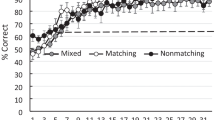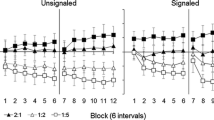Abstract
Acute and chronic effects of methsuximide and mephenytoin were examined in pigeons performing under a delayed-matching-to-sample procedure. Acute administrations of methsuximide (25–175 mg/kg) and mephenytoin (40–160 mg/kg) produced generally dose-dependent decreases in accuracy. At the two highest doses, methsuximide decreased rate of responding to the sample stimulus; mephenytoin did so only at the highest dose. At low doses, both methsuximide and mephenytoin increased response rate over control. After 20 sessions of daily exposure to methsuximide (100 mg/kg) or mephenytoin (80 mg/kg), tolerance developed to the accuracy-decreasing effects of both drugs.
Similar content being viewed by others
References
Brown PL, Jenkins HM (1968) Auto-shaping of the pigeon's key-peck. J Exp Anal Behav 11:1–8
Delaney D, Poling A (1987) Effects of methsuximide and mephenytoin on the behavior of pigeons under a repeated acquisition procedure. Pharmacol Biochem Behav 28:483–488
Gadow KD, Poling A (1987) Pharmacotherapy and mental retardation. College-Hill, San Diego (in press)
Gibbs EL, Gibbs TJ, Gibbs FA, Gibbs EA, Dikmen S, Hermann BP (1982) Antiepilepsy drugs. In: Breuning SE, Poling A (eds) Drugs and mental retardation. Thomas, Springfield, Illinois, pp 268–329
Karas CA, Picker M, Poling A (1986) Effects of phenobarbital in combination with phenytoin or valproic acid on the delayed-matching-to-sample performance of pigeons. Pharmacol Biochem Behav 25:929–932
Kulig BM (1980) The evaluation of the behavioral effects of antiepileptic drugs in animals and man. In: Kulig BM, Meinardi H, Stores G (eds) Epilepsy and behavior '79. Swets and Zeitlinger; Lisse, pp 47–62
MacLeod CM, Dekaban AS, Hunt E (1978) Memory impairment in epileptic patients. Science 202: 1102–1104
McMillan DE (1981) Effects of chemicals on delayed matching behavior in pigeons. I. Acute effects of drugs. Neurotoxicology 2:485–498
Nicholson AN, Wright CM (1974) Inhibitory and disinhibitory effects of nitrazepam, diazepam and flurazepam hydrochloride on delayed matching behavior in monkeys (Macaca mulatta) Neuropharmacology 13:919–926
Nicholson AN, Wright CM, Ferres HM (1973) Impaired performance on delayed matching in monkeys by heptabarbitone, pentobarbitone sodium and quinalbarbitone sodium. Neuropharmacology 12:311–317
Parnas J, Flachs H, Gram L (1979) Psychotropic effects of antiepileptic drugs. Acta Neurol Scand 60:329–343
Picker M, Poling A (1984) Effects of anticonvulsants on learning: Performance of pigeons under a repeated acquisition procedure when exposed to phenobarbital, clonazepam, valproic acid, ethosuximide, and phenytoin. J Pharmacol Exp Ther 230:307–316
Picker M, White W, Poling A (1985) Effects of phenobarbital, clonazepam, valproic acid, ethosuximide, and phenytoin on the delayed-matching-to-sample performance of pigeons. Psychopharmacology 86:494–498
Picker M, Leibold L, Endsley B, Poling A (1986a) Effects of clonazepam and ethosuximide on the responding of pigeons under a fixed-consecutive-number schedule with and without an external discriminative stimulus. Psychopharmacology 88:325–330
Picker M, Leibold L, Endsley B, Poling A (1986b) Modulation of the behavioral effects of anticonvulsant drugs by an external discriminative stimulus. J Pharmacol Exp Ther 238:529–535
Poling A, Picker M (1987) Behavioral effects of anticonvulsant drugs. In: Thompson T, Dews PB, Barrett JE (eds) Advances in behavioral pharmacology, vol 5. JAI Press; Greenwich, pp 157–192
Poling A, Picker M, Vande Polder D, Clark R (1986) Chronic effects of ethosuximide, phenytoin, clonazepam, and valproic acid on the delayed-matching-to-sample performance of pigeons. Psychopharmacology 88:301–304
Rall TW, Schleifer LS (1985) Drugs effective in the therapy of the epilepsies. In: Gilman AG, Goodman LS, Rall TW, Murad F (eds) The pharmacological basis of therapeutics. MacMillan, New York, pp 446–472
Schlinger H, Wilkenfield J, Poling A (1988) Effects of methsuximide and mephenytoin on the responding of pigeons under a fixed-consecutive-number schedule with and without an external discriminative stimulus. Psychopharmacology (in press)
Woodbury DM, Penry JK, Pippenger CE (1982) Antiepileptic drugs. Raven Press, New York
Author information
Authors and Affiliations
Rights and permissions
About this article
Cite this article
Schlinger, H., Poling, A. Acute and chronic effects of methsuximide and mephenytoin on the delayed-matching-to-sample performance of pigeons. Psychopharmacology 95, 82–86 (1988). https://doi.org/10.1007/BF00212772
Received:
Revised:
Issue Date:
DOI: https://doi.org/10.1007/BF00212772




